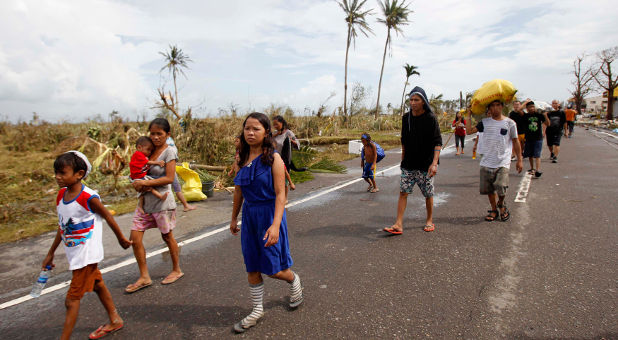One of the most powerful storms ever recorded killed at least 10,000 people in the central Philippines, a senior police official said on Sunday, with huge waves sweeping away coastal villages and devastating one of the main cities in the region.
Super typhoon Haiyan destroyed about 70 to 80 percent of structures in its path as it tore through Leyte province on Friday, said police chief superintendent Elmer Soria, before weakening and heading west for Vietnam.
As rescue workers struggled to reach ravaged villages along the coast, where the death toll is as yet unknown, survivors foraged for food or searched for lost loved ones.
“People are walking like zombies looking for food,” said Jenny Chu, a medical student in Leyte. “It’s like a movie.”
Most of the deaths appear to have been caused by surging sea water strewn with debris that many said resembled a tsunami, leveling houses and drowning hundreds of people in one of the worst disasters to hit the typhoon-prone Southeast Asian nation.
The national government and disaster agency have not confirmed the latest estimate of deaths, a sharp increase from initial estimates on Saturday of at least 1,200 killed by a storm whose sustained winds reached 195 miles per hour (313 km per hour) with gusts of up to 235 mph (378 kph).
“We had a meeting last night with the governor and the other officials. The governor said, based on their estimate, 10,000 died,” Soria told Reuters. “The devastation is so big.”
About 300 people died in neighboring Samar province, where Haiyan first hit land on Friday as a category 5 typhoon, with 2,000 missing, said a provincial disaster agency official.
Nearly 480,000 people were displaced and 4.5 million “affected” by the typhoon in 36 provinces, the national disaster agency said, as relief agencies called for food, water, medicines and tarpaulins for the homeless.
International aid agencies said relief efforts in the Philippines were stretched thin after a 7.2 magnitude quake in central Bohol province last month and displacement caused by a conflict with Muslim rebels in southern Zamboanga province.
Witnesses and officials described chaotic scenes in Leyte’s capital, Tacloban, a coastal city of 220,000 about 580 km (360 miles) southeast of Manila which bore the brunt, with hundreds of bodies piled along roads and pinned under wrecked houses.
The city lies in a cove where the seawater narrows, making it susceptible to storm surges.
The city and nearby villages as far as one kilometer (just over half a mile) from shore were flooded, leaving floating bodies and roads choked with debris from fallen trees, tangled power lines and flattened homes.
Many Internet users urged prayers and called for aid for survivors in the largely Roman Catholic nation on social media sites such as Twitter.
Aquino Considers Martial Law
“From a helicopter, you can see the extent of devastation. From the shore and moving a kilometre inland, there are no structures standing. It was like a tsunami,” said Interior Secretary Manuel Roxas, who had been in Tacloban since before the typhoon struck the city.
“I don’t know how to describe what I saw. It’s horrific.”
Looters rampaged through several stores in Tacloban, witnesses said, taking whatever they could find as rescuers’ efforts to deliver food and water were hampered by severed roads and communications. A TV station said ATM machines were broken open.
Mobs attacked trucks loaded with food, tents and water on Tanauan bridge in Leyte, said Philippine Red Cross chairman Richard Gordon. “These are mobsters operating out of there.”
President Benigno Aquino said the government had deployed 300 soldiers and police to restore order and that he was considering introducing martial law or a state of emergency in Tacloban to ensure security.
“Tonight, a column of armored vehicles will be arriving in Tacloban to show the government’s resolve and to stop this looting,” he said.
Aquino has shown exasperation at conflicting reports on damage and deaths and one TV network quoted him as telling the head of the disaster agency that he was running out of patience.
“How can you beat that typhoon?” said defense chief Voltaire Gazmin, when asked whether the government had been ill-prepared.
“It’s the strongest on Earth. We’ve done everything we can, we had lots of preparation. It’s a lesson for us.”
The U.N.’s Office for the Coordination of Humanitarian Affairs said aerial surveys showed “significant damage to coastal areas” with heavy ships thrown ashore, houses destroyed and vast tracts of agricultural land “decimated”.
The destruction extends well beyond Tacloban. Officials had yet to make contact with Guiuan, a town of 40,000 that was first hit by the typhoon. Baco, a city of 35,000 people in Oriental Mindoro province, was 80 percent under water, the U.N. said.
There were reports of damage across much of the Visayas, a region of eight major islands, including Leyte, Cebu and Samar.
Many tourists were stranded. “Seawater reached the second floor of the hotel,” said Nancy Chang, who was on a business trip from China in Tacloban City and walked three hours through mud and debris for a military-led evacuation at the airport.
“It’s like the end of the world.”
Six people were killed and dozens wounded during heavy winds and storms in central Vietnam as Haiyan approached the coast, state media reported, even though it had weakened substantially since hitting the Philippines.
Vietnam authorities have moved 883,000 people in 11 central provinces to safe zones, according to the government’s website.
Tacloban city airport was all but destroyed as seawaters swept through the city, shattering the glass of the airport tower, leveling the terminal and overturning nearby vehicles.
The European Commission said it would provide 3 million euros to help in relief efforts in the worst affected areas. The U.S. embassy said it would provide $100,000 for health, water and sanitation support. Australia said it would provide an initial 15.5 million pesos ($358,900) in relief supplies.
The World Food Programme said it was airlifting 40 tonnes of high-energy biscuits, enough to feed 120,000 people for a day, as well as emergency supplies and communications equipment.
($1 = 43.1900 Philippine pesos)
Additional reporting by Rosemarie Francisco and Karen Lema; Editing by Jason Szep and Nick Macfie
© 2013 Thomson Reuters. All rights reserved.
See an error in this article?
To contact us or to submit an article





















